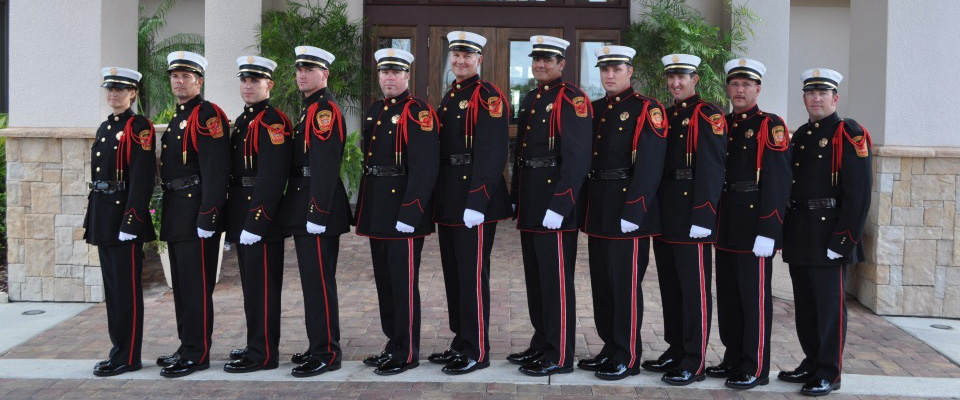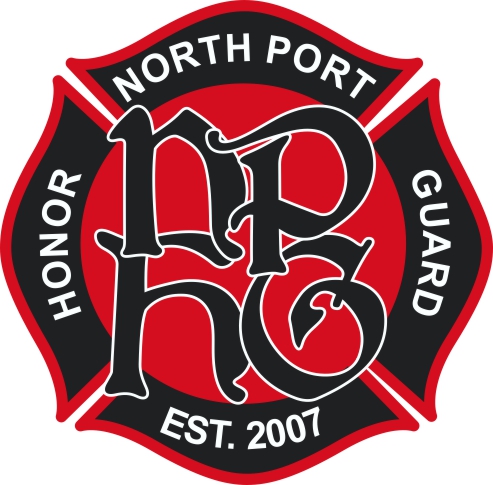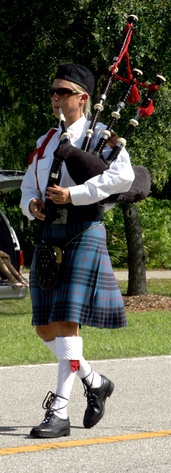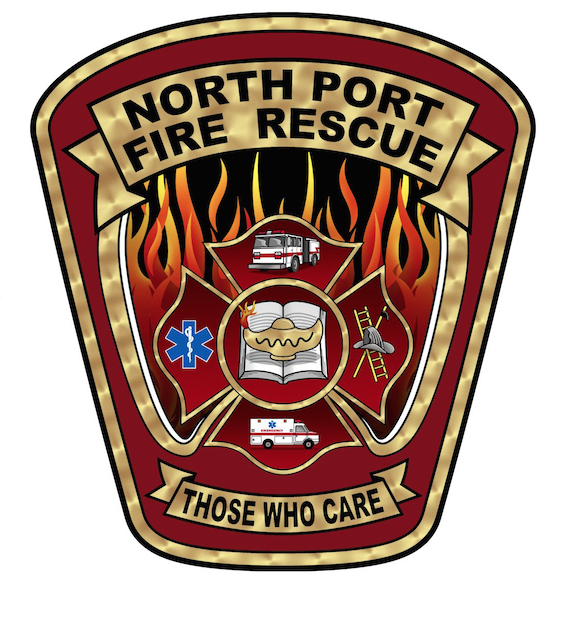Honor Guard and Fire Service Traditions

Mission
 The North Port Fire Rescue District's Honor Guard was formed in 2007. They have attended formal training at Florida State Fire College, marched in the local community celebration parades, attended new station grand openings (ring in-service), and participated in award ceremonies, as well as various other social functions and duties.
The North Port Fire Rescue District's Honor Guard was formed in 2007. They have attended formal training at Florida State Fire College, marched in the local community celebration parades, attended new station grand openings (ring in-service), and participated in award ceremonies, as well as various other social functions and duties.
Our mission is to strive to honor firefighters in life, as well as death, and to exhibit the best possible image to the entire community. We strive to accomplish this with the highest degree of professionalism, dedication, loyalty, honor and dignity possible. Our purpose is to represent North Port Fire Rescue by projecting a positive image, and performing as a well-trained team at events and formal occasions as directed by the Fire Chief.
The North Port Fire Rescue District's Honor Guard is available to assist and/or work in conjunction with other honor guards for "Line of Duty" funerals and memorial services for all Fire, EMS and Police personnel as requested. In addition to funerals and memorial services, the honor guard may be called on to post colors, march in parades, attend new station grand openings, social functions, and assist the families of our fallen brothers and sisters during their time of need. To request the North Port Fire Rescue District's Honor Guard please call (941) 240-8150.
Why do the Police and Fire Departments play "Amazing Grace" on the Bagpipes at funerals?
 The tradition of bagpipes played at fire department and police department funerals in the United States goes back over one hundred fifty years. When the Irish and Scottish immigrated to this country, they brought many of their traditions with them. One of these was the bagpipe, often played at Celtic weddings, funerals and ceili (dances).
The tradition of bagpipes played at fire department and police department funerals in the United States goes back over one hundred fifty years. When the Irish and Scottish immigrated to this country, they brought many of their traditions with them. One of these was the bagpipe, often played at Celtic weddings, funerals and ceili (dances).
It wasn't until the great potato famine and massive Irish immigration to the East Coast of the United States that the tradition of the bagpipes really took hold in the fire department. In the 1800's, Irish immigrants faced massive discrimination. Factories and shops had signs reading "NINA" - No Irish Need Apply. The only jobs they could get were the ones no one else wanted - jobs that were dirty, dangerous, or both - firefighters and police officers. It was not an uncommon event to have several firefighters killed at a working fire. The Irish firefighters' funerals were typical of all Irish funerals - the pipes were played. It was somehow okay for a hardened firefighter to cry at the sound of bagpipes when his dignity would not let him weep for a fallen comrade.
Those who have attended a funeral where bagpipes were played know how haunting and mournful the sound of the pipes can be. The most famous song played at fire and police funerals is Amazing Grace. It wasn't too long before families and friends of non-Irish firefighters began asking for the bagpipes to be played for fallen heroes. The bagpipes add a special air and dignity to this solemn occasion.
Bagpipe bands represent both fire and police often have more than 60 uniformed playing members. They are also traditionally known as Emerald Societies after Ireland - the Emerald Isle. Many bands wear traditional Scottish dress while others wear the simpler Irish uniform. All members wear the kilt and tunic, whether it is a Scottish clan tartan or Irish single color kilt.
Today, the tradition is universal and not just for the Irish or Scottish. The bagpipes have become a distinguishing feature of a fallen hero's funeral.
Bell Ringing
The ceremonial ringing of the bell in memory of those who died in the line of duty is an age old tradition of the Fire Services that dates back over 150 years. The tradition reflects respect and honor to those who gave their lives to their duty.
The men and women of today's fire service are confronted with a more dangerous work environment than ever before. We are forced to continually change our strategies and tactics to accomplish our tasks.
Our methods may change, but our goals remain the same as they were in the past, to save lives and to protect property, sometimes at a terrible cost. This is what we In the past, as fire fighters began their tour of duty, it was the bell that signaled the beginning of that day's shift. Throughout the day and night, each alarm was sounded by a bell, which summoned these brave souls to fight fires and to place their lives in jeopardy for the good of their fellow citizen. And when the fire was out and the alarm had come to an end, it was the bell that signaled to all the completion of that call. When a fire fighter had died in the line of duty, paying the supreme sacrifice, it was the mournful toll of the bell that solemnly announced a comrades passing.
We utilize these traditions as symbols, which reflect honor and respect on those who have given so much and who have served so well. To symbolize the devotion that these brave souls had for their duty, a special signal of three rings, three times each, represents the end of our comrades' duties and that they will be returning to quarters. And so, to those who have selflessly given their lives for the good of their fellow man, their tasks completed, their duties well done, to our comrades, their last alarm, they are going home.
A distinctive bell ringing marks the end of an emergency and a return to quarters. In memory of all who died during the attacks on September 11, 2001 the bell is rung five times in series of fives (5 x 5 x 5 x 5 x 5). Multiplied out this equals 3,125, a number very close to the number of people who died as result of the attacks.
The Maltese Cross
 The Badge of a Firefighter is the Maltese Cross. The Maltese Cross is a symbol of protection and a badge of honor. Its story is hundreds of years old. The Maltese cross is known around the world as a symbol of the fire service. It is often seen painted on fire trucks, on the clothing of firefighters, depicted on firefighter’s badges, and is quite often the chosen design of firefighter tattoos. So where did the Maltese cross come from, and how did it get to be known as a symbol of the fire service?
The Badge of a Firefighter is the Maltese Cross. The Maltese Cross is a symbol of protection and a badge of honor. Its story is hundreds of years old. The Maltese cross is known around the world as a symbol of the fire service. It is often seen painted on fire trucks, on the clothing of firefighters, depicted on firefighter’s badges, and is quite often the chosen design of firefighter tattoos. So where did the Maltese cross come from, and how did it get to be known as a symbol of the fire service?
When a courageous band of crusaders known as Knights of St. John fought the Saracens for possession of the holy land, they encountered a new weapon unknown to European warriors. It was a simple, but horrible device of war. It caused excruciating pain and agonizing death upon the brave fighters. The Saracens weapon was fire. As the crusaders advanced on the walls of the city, they were struck by glass bombs containing naphtha. When they became saturated with the highly flammable liquid, the Saracens hurled a flaming torch into their midst. Hundreds of the knights were burned alive; others risked their lives to save their brothers-in-arms from dying painful, fiery deaths.
Thus, these men became the first of a long list of courageous Firefighters. Their heroic efforts were recognized by fellow crusaders who awarded each hero a badge of honor; a cross similar to the one firefighters wear today. Since the Knights of St. John lived for close to four centuries on a little island in the Mediterranean Sea named Malta, the cross came to be known as the Maltese Cross. The Maltese Cross is a symbol of protection. It means that the Firefighter who wears this cross is willing to lay down their life for others just as the crusaders sacrificed their lives for their fellow man so many years ago.
The Maltese Cross is a Firefighter's badge of honor, signifying that they work in courage...a ladder rung away from death.
The shoulder patch of North Port Fire Rescue (above) incorporates the modern-day version of the Maltese Cross in its center.